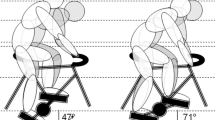Summary
Force measurements on the pedal and crank during work on a bicycle ergometer revealed that:
-
1.
Force exertion is maximal when the position of the pedal is in the front at about 90 ° to the vertical line.
-
2.
The passive (hind) leg is lifted partly by the active (force exerting) leg. This effect diminishes at higher loads.
-
3.
Peak loads in one cycle are about twice the load-setting on the specific ergometer.
-
4.
Toe-elips on the pedals are probably not always used to pull at the pedals.
-
5.
The application of force measurements in several experiments concerned with ergometry and cycling is discussed.
Similar content being viewed by others
References
Abbott, B. C., andB. Bigland: The effects of force and speed changes on the rate of oxygen consumption during negative work. J. Physiol. (Lond.)120, 319 (1953).
— —, andJ. M. Ritchie: The physiological cost of negative work. J. Physiol. (Lond.)117, 380 (1952).
Asmussen, E.: Positive and negative muscular work. Acta physiol. scand.28, 364 (1952).
Åstrand, I., P.-O. Åstrand, andA. Stunkard: Oxygen intake of obese individuals during work on a bicycle ergometer. Acta physiol. scand.50, 294 (1960).
Åstrand, P.-O.: Study of bicycle modifications using a motor driven treadmillbicycle ergometer. Arbeitsphysiologie15, 23 (1953).
Atkins, A. R., andJ. D. Nicholson: An accurate constant-work-rate ergometer. J. appl. Physiol.18, 205 (1963).
—, andA. Nünlist: A precision work-rate ergometer. J. appl. Physiol.21, 1427 (1966).
Bleeker, J., andF. H. Bonjer: A calibration device for Controlling and adjusting ergometers (in Dutch). Polytechn. Tschr.14, 637 (1960).
Carlsöö, S., andS. Molbech: The functions of certain two-joint muscles in a closed muscular chain. Acta morph. neerl. scand.6, 377 (1966).
Dempsey, J. A., W. Reddan, B. Balke, andJ. Rankin: Work capacity determinants and physiologic cost of weight-supported work in obesity. J. appl. Physiol.21, 1815 (1966).
Dickinson, S.: The dynamics of bicycle pedalling. Proc. roy. Soc. B103, 225 (1928).
—: The efficiency of bicycle-pedalling as affected by speed and load. J. Physiol. (Lond.)67, 242 (1929).
Eckermann, P., u.H. P. Millahn: Der Einfluß der Drehzahl auf die Herzfrequenz und die Sauerstoffaufnahme bei konstanter Leistung am Fahrradergometer. Int. Z. angew. Physiol.23, 340 (1967).
Fenn, W. O.: Zur Mechanik des Radfahrens in Vergleich zu der des Laufens. Pflügers Arch. ges. Physiol.229, 354 (1932).
Grosse-Lordemann, H., u.E. A. Müller: Der Einfluß der Leistung und der Arbeitsgeschwindigkeit auf das Arbeitsmaximum und den Wirkungsgrad beim Radfahren. Arbeitsphysiologie9, 454 (1937).
Hamley, E. J., and V.Thomas: Physiological and postural factors in the calibration of the bicycle ergometer. J. Physiol. (Lond.)191, 55 P (1967).
Hess, P., u.J. Seusing: Der Einfluß der Tretfrequenz und des Pedaldruckes auf die Sauerstoffaufnahme bei Untersuchungen am Ergometer. Int. Z. angew. Physiol.19, 468 (1963).
Houtz, S. J., andF. J. Fischer: An analysis of muscle action and joint excursion during exercise on a stationary bicycle. J. Bone Jt Surg.41-A, 123 (1959).
Kogi, K., E. A. Müller u.W. Rohmert: Die relative Wirkung isometrischen und dynamischen Trainings auf die Ausdauer bei dynamischer Arbeit. Int. Z. angew. Physiol.20, 465 (1965).
Lanooy, C., andF. H. Bonjer: A hyperbolic ergometer for cycling and cranking. J. appl. Physiol.9, 499 (1956).
Mellerowicz, H., H. H. Reindell, W. Hollmann, H. Mies u.H. Roskamm: Vorschläge zur Standardisierung der ergometrischen Leistungsmessung. Z. Kreisl.- Forsch.50, 273 (1961).
Müller, E. A.: Der Einfluß der Sattelstellung auf das Arbeitsmaximum und den Wirkungsgrad beim Radfahren. Arbeitsphysiologie10, 1 (1938a).
—: Der Einfluß der Trägheit auf das Arbeitsmaximum beim Radfahren. Arbeitsphysiologie10, 436 (1938b).
—: Energieumsatz und Pulsfrequenz bei negativer Muskelarbeit. Arbeitsphysiologie15, 196 (1953b).
—, u.H. Grosse-Lordemann: Der Einfluß der Tretkurbellänge auf das Arbeitsmaximum und den Wirkungsgrad beim Radfahren. Arbeitsphysiologie9, 619 (1937).
—,Th. Hettinger u.G. F. Kuhn: Arbeitsphysiologische Versuche über das Radfahren mit einem Kunstbein. Z. Orthop.84, 462 (1953a).
Snellen, J. W.: Negative work during walking and cycling on a motor-driven treadmill. Acta physiol. pharmacol. neerl.14, 363 (1967).
Author information
Authors and Affiliations
Rights and permissions
About this article
Cite this article
Hoes, M.J.A.J.M., Binkhorst, R.A., Smeekes-Kuyl, A.E.M.C. et al. Measurement of forces exerted on pedal and crank during work on a bicycle ergometer at different loads. Int. Z. Angew. Physiol. Einschl. Arbeitsphysiol. 26, 33–42 (1968). https://doi.org/10.1007/BF00696088
Received:
Issue Date:
DOI: https://doi.org/10.1007/BF00696088




